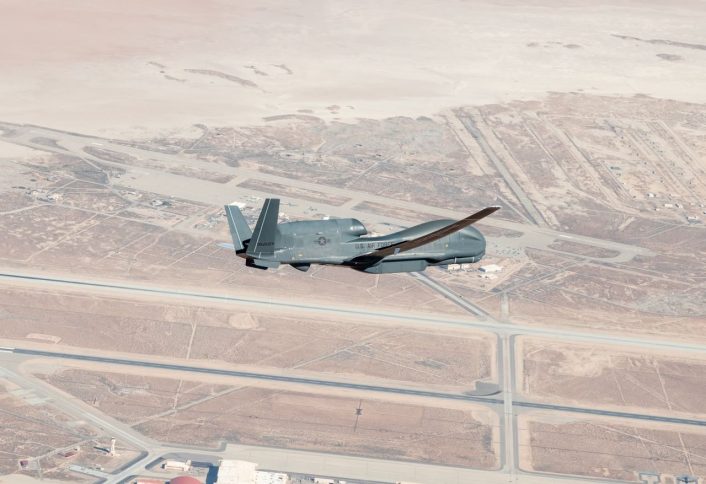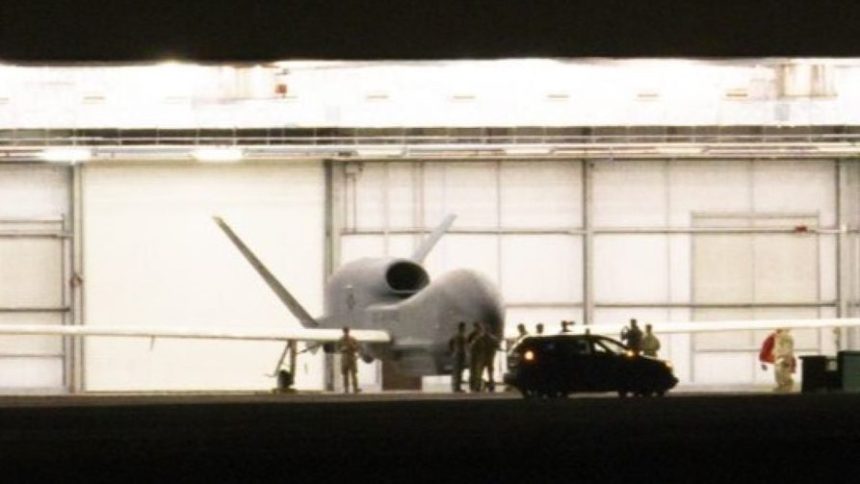While at RAF Fairford, the RQ-4 will conduct operations through international and Allied airspace, implementing the U.S. Air Force’s Agile Combat Employment concept.
A U.S. Air Force RQ-4 Global Hawk drone made aviation history by landing in the United Kingdom for the first time on Aug. 22, 2024, becoming also the largest UAS to ever land in the country. The unmanned aircraft touched down at RAF Fairford at around 22:30 (local time) for a deployment of an undisclosed duration.
The RQ-4B, with the callsign FORTE12 and serial number 11-2046, took off from Naval Air Station Sigonella, on the Italian island of Sicily, on Aug. 21. The aircraft flew north skirting the western Ukrainian, Belarussian and Russian borders while flying over Eastern Europe, the Baltic states and Finland.
History as the RQ-4 Global Hawk arrives in the UK for the first time. The Unmanned Aerial Vehicle (UAV) will likely replace the U2 Dragon Lady as US Air Force High Altitude Reconnaissance Aircraft operating out of RAF Fairford, UK. 🇺🇸 🇬🇧
All videos: https://t.co/3f1AHpm0Pn pic.twitter.com/YnZB5Mwuje
— CobraEmergency (@CobraEmergency) August 23, 2024
The track observed through ADS-B on flight tracking websites shows the Global Hawk orbiting for some hours over Estonia, before continuing the flight over Finland. The aircraft, once reached Finland’s northern border, turned back and flew over the Baltic Sea, Sweden and Norway on the way to RAF Fairford.
Yesterday, USAF RQ-4B 11-2046 with c/s FORTE12 took off from Sigonella AB, IT and spent ~23 hrs in the air over the Baltics & Finland before landing at RAF Fairford, UK.
This is the 1st time a US RQ-4 has deployed to the UK & the 2nd time an RQ-4 has flown over Finland.#AE5421 pic.twitter.com/u5VNlSnzo5
— Amelia Smith (@ameliairheart) August 23, 2024
A new mission was launched on Aug. 24, with the RQ-4 tracked orbiting over Finland and Estonia. The route of these missions is similar to many we saw during the ongoing war in Ukraine, where NATO ISR (Intelligence, Surveillance and Reconnaissance) in support of Kyiv has considerably handed Russia many tactical setbacks and prevented it from achieving a complete breakthrough.
The deployment
A statement by USAFE-AFAFRICA (U.S. Air Forces Europe-Africa) said that the deployment was part of an effort “to diversify operating locations and enhance integration with NATO Allies.” The statement also confirmed this is the first RQ-4 deployment to England, adding that “the deployed U.S. RQ-4 will conduct operations through international and Allied airspace in accordance with international norms and standards.”
Even more interesting is that the deployment is considered an implementation of the Air Force’s ACE (Agile Combat Employment) concept, which has come to dictate almost all of the service’s squadron, unit, base and formation-level exercises for future high-end wars with peer competitors. Under ACE, “aircraft may be dispersed from typical operating locations to alternate airfields to enhance survivability.”
The concept involves planes operating from non-conventional airfields and even large roads and highways with little supporting infrastructure and equipment. This is with a view to spread out from the bigger bases, which are vulnerable to adversary missile strikes, instead of concentrating forces there, while also holding enemy targets at risk from multiple locations. It is however not clear how ACE will be practiced with the Global Hawk.
At RAF Fairford, the RQ-4 will be supported by the 501st CSW (Combat Support Wing), which has routinely supported similar deployments. These include the BTF (Bomber Task Force) missions and the deployment of the U-2 Dragon Lady manned ISR planes.
“The support and execution of these missions demonstrate U.S. commitment to NATO Allies and partners and set conditions for potential future operations in the U.S. European Command area of responsibility,” said the statement. Fairford meanwhile also hosts a detachment of U-2, which will eventually be replaced by the RQ-4 as the type is retired.

According to Air and Space Forces, the FAA (Federal Aviation Authority) requires autonomous aircraft to fly within approved corridors. Thus Britain’s CAA (Civilian Aviation Authority) “established such a corridor for an uncrewed aircraft like the Global Hawk earlier this year.” Its flights from Fairford “will likely be timed for nighttime hours to minimize the impact on civilian air traffic in the vicinity, as the aircraft climbs to or descends from its 50,000-foot operating altitude.”
Aviation Week published further details, mentioning that, according to the CAA, the flight is the first of two planned for August to ensure that the flight operations comply with the conditions set by the regulator agency. The British Ministry of Defense requested changes to the local airspace to allow UAS operations from RAF Fairford in 2021.
The CAA green-lighted the RQ-4 flights in February 2024, after the creation of the EDG218 segregated airspace complex that will allow the unmanned aircraft to safely climb to and descend from its operating altitude. The airspace is activated with a 3-hour window to not only accommodate the operation, but also allow sufficient time for contingencies.
Use and significance
The Air Force currently fields the RQ-4 Block 30 and Block 40. Block 30 is a multi-intelligence platform that simultaneously carries electro-optical, infrared, synthetic aperture radar (SAR), and high and low band SIGINT sensors. Block 40 carries the Radar Technology Insertion Program (RTIP) active electronically scanned array radar which provides MTI and SAR data.
The Global Hawk provides persistent near-real-time coverage using its imagery intelligence (IMINT), signals intelligence (SIGINT) and moving target indicator (MTI) sensors. Kremlin-aligned Telegram channels like Rybar and Military Informant have also claimed the RQ-4 possess ELINT (Electronic Intelligence) systems that identify Russian ground-based Air Defense radars.
This intelligence also helps Ukraine plan and execute its ATACMS (Army Tactical Missile System), Storm Shadow/SCALP ALCM (Air-Launched Cruise Missile) attacks or its kamikaze USV (Unmanned Surface Vessel) strikes in the Black Sea. Russia has lost many of its vaunted S-400 AD platforms to these strikes.
The RQ-4, MQ-9 Reaper, E-3 Sentry AWACS and the RC-135 Rivet Joint often work in consonance in sweeping electronic emissions and identify periodical gaps in Russia’s radar coverage. Similarly to the RQ-4, these aircraft can be observed flying over the Black Sea or near Ukrainian and Belarusian borders.









